Ranch, animal farm & feedlot confined spaces
Confined spaces on ranches, animal farms, and feedlots can be dangerous. Employers and workers must understand the hazards and know how to work with them before entering the confined space.
The hazards
Below, you'll find general information to help you assess the hazards of confined spaces on ranches, animal farms, and feedlots. Please note: there may be confined spaces on your farm that are not listed here.
Ranches and feedlots usually have plastic and steel tanks with hatches on top for storing liquid additives for feed production. A biofilm is likely to form on the insides of these tanks. Power washing the insides of the tanks can cause exposure to micro-organisms in the biofilm. The biofilm is also likely to be very slippery.
Organic debris can sink to the bottom and form sludge. As this sludge decays, highly toxic gases can form. These gases are unlikely to be released if the water is clean and the sludge at the bottom of the tank is not moved. Cleaning and servicing the tanks can disturb the sludge, releasing highly toxic gases that can quickly cause death when inhaled at high concentrations. Using cleaners and disinfectant products can also be dangerous.
| Hazards | Hazardous work |
|
|
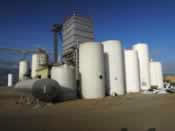
Additive tanks
Augers and conveyors transport solid material either from a container to a vehicle or from one location to another. The enclosure containing the auger or conveyor is considered a confined space. Augers and conveyors that are not enclosed contain moving equipment (such as rollers and belts) that could pose a risk to workers.
Depending on the material being moved, toxic gases may build up in the conveyor system. Feed can emit fumigants and dust. Bacteria and mould can also grow in accumulated dust with sufficient moisture.
| Hazards | Hazardous work |
|
|
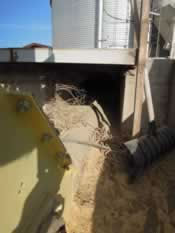 |
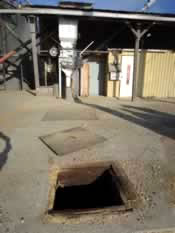 |
| Auger tunnel | Auger tunnel hatchway |
If there is not enough ventilation, crawl spaces or cellars may contain a toxic or low-oxygen atmosphere. The combination of metal and moisture can deplete oxygen because oxygen is used as metal rusts. Other toxic gases may also accumulate, depending on the use of the building above the crawl space or material being stored in the crawl space.
| Hazards | Hazardous work |
|
|
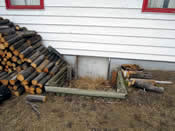 |
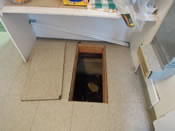 |
| Exterior crawl space entrance | Interior crawl space entrance |
Feed bins are elevated above ground and have tapered bases and an entry hatch in the top. These bins are confined spaces.
Normally, storing grain or feed in bins does not produce toxic gases. However, if the grain's moisture content is too high, the grain may ferment. Then, toxic gases can build up and replace oxygen in the air. Before entering the bins you must also consider where any pesticides or fumigants were used previously. You must also think about whether mould might be present.
Grain may not flow smoothly and can form bridges or shoulders. These are a real hazard as they can engulf, or completely surround, a worker. Workers may also be struck by fragments of bridges and hang-ups.
| Hazards | Hazardous work |
|
|
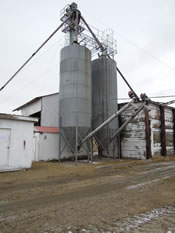
Feed bins
Some ranches and feedlots manufacture feed on-site. This involves grinding and blending the ground material with liquid and solid additives to create the final product.
Grain bins have flat or tapered bases. Some tapered bases may be below ground. Bins also have side access doors and one or more access hatches on top.
Depending on the amount of grain in the bin, entry may be possible through:
- The top hatch only
- A combination of the top and side hatches
- Partial opening of the side door
- Complete opening of the side door
When entry is necessary from the top or through partial opening of the full-sized side door, a bin is considered a confined space. Bins with sloped floors might always be considered confined spaces because they are difficult to access.
Normally, storing grain in bins does not produce toxic gases. However, if the grain's moisture content is too high, the grain may ferment. Then, toxic gases can build up and replace oxygen in the air. Before entering the bins, you must also consider any previous use of pesticides or fumigants, or possibly mould.
Grain may not flow smoothly and can form bridges or shoulders. These are a real hazard as they can engulf, or completely surround, a worker. Workers may also be struck by fragments of bridges and hang-ups.
| Hazards | Hazardous work |
|
|
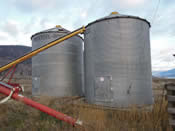 |
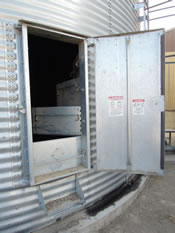 |
| Grain bins | Grain bin |
Mobile equipment used on ranches and feedlots may include:
- Tank wagons (e.g., pesticides, fertilizers, and liquid manure)
- Mixers (e.g., for mixing feed)
- Spreaders (e.g., for fertilizers)
Tanks may contain toxic gases from fermenting material, such as liquid manure, or aerosols from pesticides. These gases and vapours are toxic and can quickly cause death when inhaled at high concentrations. Some cleaning chemicals can also produce very toxic gases, even in small amounts. Also, low-oxygen conditions may occur if the tank has been empty for some time.
Interior surfaces in these structures are also likely to be very slippery, which could lead to entrapment. Mixers and spreaders contain moving mechanical parts. As a worker, you may be seriously injured or even killed if you fall into the operating machinery or if mechanical equipment is not locked out.
The power take-off of the tractor powers mechanical equipment on the unit, and the hydraulic system of the tractor powers the unit's hydraulic system. It's possible for energy to remain in circuits after the tractor has been shut down and linkages and hoses have been disconnected.
To help reduce the risk, choose (or retrofit) equipment so workers don't have to enter mixers or spreaders.
| Hazards | Hazardous work |
|
|
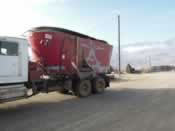 |
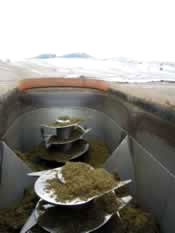 |
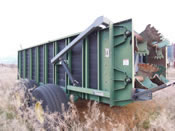 |
| Feed mixer |
Mechanical equipment in a feed mixer |
Solid manure spreader |
Fuel and products such as liquid fertilizer solution are stored in tanks for use on demand.
The airspace in fuel and chemical tanks contains residual vapours that may be very toxic and may have a low flashpoint (temperature at which a chemical can vaporize and form an ignitable mixture in air).
A biofilm is likely to form on the insides of tanks holding water-based products. Wet surfaces in the tanks are also likely to be very slippery.
| Hazards | Hazardous work |
|
|
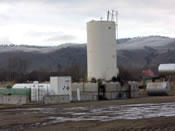 |
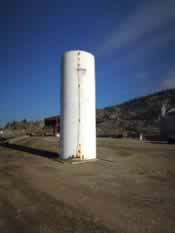 |
| Fuel tank | Fertilizer solution tank |
Ranches and feedlots in rural areas aren't part of municipal sanitary collection systems. These operations must have stand-alone sewage treatment facilities, including septic tanks and processing chambers.
Wastewater treatment can result in low oxygen conditions and produce toxic gases in these confined spaces. Inhaling these toxic gases at high concentrations can quickly cause death.
| Hazards | Hazardous work |
|
|
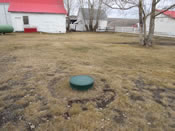
Septic tank hatch
Scales are used for weighing animals and feed. A scale pit is a chamber located under the movable part of the scale. Access to the pit is from hatches on the top or side. These pits are confined spaces.
Scale pits can contain residual feed or manure. If there's moisture in the feed, it may ferment. Toxic gases can then build up and replace oxygen in the air. Fermenting manure can also produce very toxic gases.
| Hazards | Hazardous work |
|
|
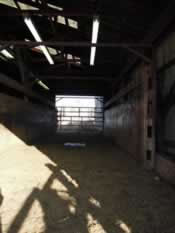 |
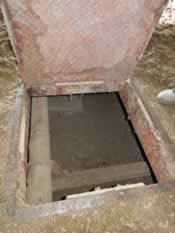 |
| Scale pit | Scale pit hatchway |
Ranches and feedlots have storage tanks that hold potable water.
Normally, hazardous gases won't be present in a water tank provided the water is clean. However, a biofilm and sludge can form inside the tank. Some cleaning and disinfecting chemicals can produce very toxic gases, even in residual quantities.
Low-oxygen conditions may also occur if the tank has been empty for some time. The greatest risk is from drowning, which can occur in as little as 15 cm of water.
| Hazards | Hazardous work |
|
|
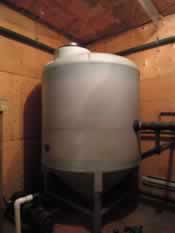
Water storage tank
A well pit is the chamber at the top of a wellhead. A chamber located under the floor of a building is considered a confined space.
The well pit provides access to the well and pumping equipment. It also prevents freeze-up in the pressure tank and piping.
Normally, hazardous gases won't be present in a well, as long as there is very little (or no) organic material in the water. However, oxygen depletion can occur when metal rusts. This is most likely to happen when the well pit is closed for a long time, as condensation forms on metal surfaces.
| Hazards | Hazardous work |
|
|
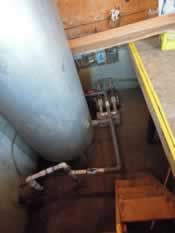
Well pit
Highlights
- New risk advisory on the dangers of fire and explosion in asphalt mix plants Published on: August 15, 2023
- New resource outlines how to protect workers from encounters with hazardous wildlife Published on: July 21, 2023
- New online tool helps workers and employers manage risk by delivering a custom list of health and safety resources Published on: December 05, 2022
- New slide show highlights the importance of protecting workers from the hazards of confined spaces in agriculture Published on: August 29, 2022

